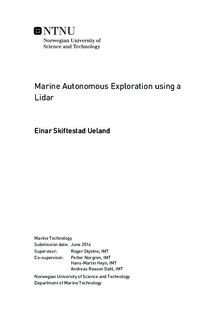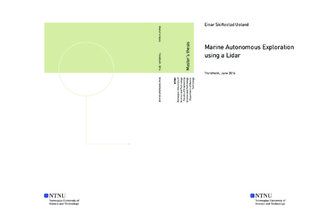| dc.description.abstract | This thesis reviews the complete design of a control system on a marine surface vessel, capable of autonomous exploration in small-scale marine environments. This involves the development of strategies for map exploration, path planning, navigation, and motion control. Further, the thesis describes how these components are merged into one autonomous system.
The experimental platform utilized in this project is the CS Saucer, a model-scale vessel built for testing in the Marine Cybernetics Laboratory at NTNU. The vessel has been extensively upgraded during this project. This includes the installation of new hardware and software, and significant improvements in the vessels capabilities of track following.
The system is installed on the Robot Operating System, a flexible platform with a large open-source community. This platform has made it possible to implement tools familiar within the robotics community such as algorithms for performing simultaneous localization and mapping.
%The maps that are generated from these algorithms are occupancy-grids, where each cell in the grid is recognized as either a free, occupied or unexplored.
Two strategies for exploration are considered in the thesis, where the Frontier Based Exploration strategy is the preferred one. In this strategy the vessel always moves to the edges between known and unknown area.
A version of the A* search algorithm has been implemented, responsible for planning paths to locations within the vessels environment. This algorithm is implemented such that node connections may span more than one cell, and with a scheme for weighting cells such that the vessel keeps a distance from walls. The generated paths are in general found to be satisfying.
A velocity control law that generates controller setpoints for the motion controller based on planned path and distance to nearby objects has been introduced to the system. The software components responsible for this operation iterates much faster than desired paths are recalculated. In this manner, the system is able to generate a steady stream of setpoints for the motion controller.
The resulting system has been tested through simulations, and subsequently verified in experiments performed in a basin facility. The experiments are well documented and are presented in a separate chapter of the thesis. A video demonstrating the successful experiments is referenced in the main body of the thesis.
An interface where the operator can interrupt the exploration process and direct the vessel to any position in the explored map has also been created and successfully tested. | |

